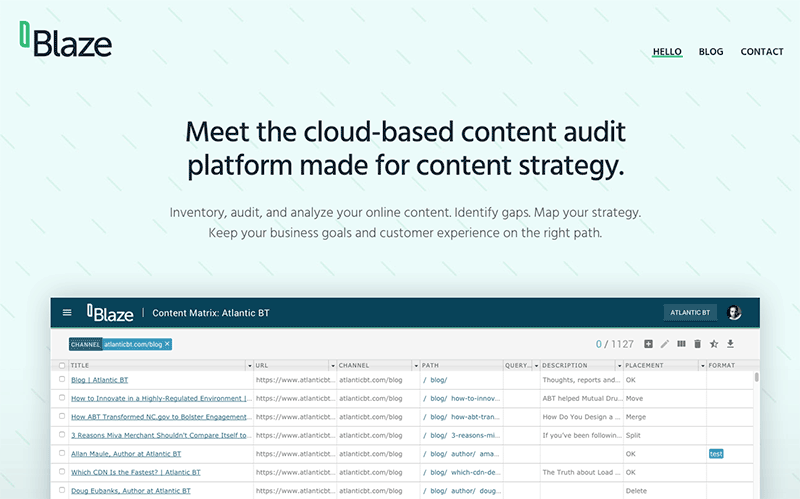In the modern world, where information overload, infobesity, intoxication, information glut, and data smog are becoming our reality rather than some fancy lingo, we know how hard it is to fight for the public’s attention.
It would not be an overstatement to say that attention is our new currency. When it comes to driving attention to a business, there is no space for trial and error as one must know exactly what they are doing.
There are essentially two ways to capture attention and drive traffic to your business’ website: to buy it through advertising or to build it up organically by posting quality content on your blog.
While the former may turn out rather expensive, especially if your business niche is competitive (well, whose isn’t?), a well-thought-out blog may be surprisingly more effective than one might think.
First of all, good content will last longer and can be repurposed later. For example, you can use some of your blog’s articles as a basis for guest posts, provided that the topic is still on point. So investing in a good piece of content has the potential to generate leads for a long time ahead.
In addition to this very straightforward benefit, quality content will help you build brand awareness and trust with your target audience, helping your customers move quicker through their buyer’s journey. You will also be able to educate your customers, earn their loyalty, and position yourself as an industry expert. Sounds pretty promising, doesn’t it?
However, as with all good things in life, the content on your business blog requires your continuous effort and thorough attitude in order to realize its full potential. You should keep the score of a whole load of not-so-obvious aspects to be able to tweak your content at the right time. In other words, content should be analyzed all the time.

What is Content Analysis?
Though many-faceted as a general concept, content analysis is something every content marketer regularly does, so there are plenty of resources out there on the web (not to mention lots of content analysis tools) that will prompt you on how to gather data, what to look for and, most importantly, what to do with your findings.
In broader terms, content analysis is an exercise that allows one to measure the quality of published content, be it text, video, images, or any other type of content, and decide whether the chosen content strategy is effective enough or if it needs a change of pace.
Why is Content Analysis Important?
Content analysis is a diagnostic tool. As we know, early diagnosis and prevention are always get us closer to a cure. Timely content analysis allows you to pinpoint weak areas in your blog content and will prompt you where you need a backup or a profound rearrangement before you start losing your potential leads.
We rarely post content on a business blog just for the content per se, and that’s totally fine. Every piece of content is there to serve a particular purpose. It is supposed to deliver our overall image, values, and tone of voice in addition to being unique and informative. Content is also supposed to sell… Or have I mentioned that already? 🙂
Thus, through analysis of our blog posts, we must ensure that they are consistent with our business priorities, i.e. do not contradict the company’s code of ethics, its mission, and vision at the very least.
It goes without saying that your blog content should be complete and useful. Continuous content analysis will help you show respect to your readers and avoid long reads of questionable relevance stuffed with keywords like the Thanksgiving turkey.
Findability with search engines is no less important as even the most insightful posts will not bring you anywhere if your blog is invisible on the web. However, since we aim high and expect our content to generate full-fledged conversions rather than mere website visits and views, we have to always keep our target audience in mind, making the blog content clear and reader-oriented. Actually, this works both ways: websites with credible and engaging content are more likely to get the most popular keywords.
What to Analyze First
Since some of the aspects mentioned above are of more qualitative nature, they may be difficult to evaluate and interpret. However, there are elements in this ecosystem, which will clearly show you if the things are going according to the plan. So, before you do any in-depth analysis of a specific blog post, consider the following:
Sales
Of course, this is probably the most straightforward evidence of the effectiveness of your blog content. Measure how many people end up on your website through your blog and eventually complete the target action: make a purchase, start a free trial and continue using it without canceling, etc., and you’ll know whether your content is engaging and persuasive.

Secondary or “assisted” conversions
This is another reliable way to evaluate the quality of your content. More so, it can show more precisely which posts are particularly good at putting your blog visitors through the marketing funnel. Just see how many blog visitors do the target action a specific post encourages them to do: click on a link, download an ebook, text ‘kudos’ in the comment section, etc.
Chatbot interactions
If there is a chatbot on your website, take some time to analyze how the readers of your blog interact with it. This may throw some light onto their overall interest in your content and whether it prompts them to move closer to the purchase.
Higher/lower ranking
Visibility in search is another KPI to look at while analyzing the quality of your blog content. Using Google Search Console, you will be able to see all of your website pages in descending order of popularity with the SERP ranking and click-through rate for each. This way you will see if a particular piece of content increases in rank or loses its position and then plan your actions accordingly.
Key Metrics to Use
Although there are plenty of quantitative metrics that will help you analyze the effectiveness of your blog content, here are some that should be monitored regularly:
Traffic metrics
These are quite obvious. Your blog was essentially designed to drive traffic to your website, so it is only natural that you will relentlessly monitor these figures for insights regarding your content quality.
Page views and unique views per page
While page views is a very direct metric showing how many times a particular page was visited, it can be rather misleading as it will still count page views if the same user returns to the home page by hitting the ‘back’ button. So in this regard, unique views per page will be more informative as this metric will demonstrate the real traffic attracted by a particular piece of content.
Time on page
This one is rather indicative of how interested the users are in the actual post located on your blog. The more engaging the content, the more likely your users are to stay on the page to read it all. However, beware of the pitfalls. For example, Google Analytics counts the time spent on a page by using the time of the next page view on the same website. So, if a user reads your blog post and then immediately leaves the website or closes the browser, the time on page value will be equal to zero.

Bounce Rate
Bounce rate is another traffic metric that may help you determine how effective your CTAs are. This figure shows how many visitors opened your page and left without completing any further actions on the website. High bounce rate is generally not good. However, to interpret this metric correctly, one should take into account the type of content in the blog post you are reviewing. If, say, the blog post was purely informative and the visitor spent enough time on the page and then left, this can be counted as a ‘good bounce’ as the user has probably got what they wanted.
Engagement metrics
Once a visitor landed on your blog post, it is a good idea to prompt them to engage with your content in one way or another. Engagement with content implies that the reader feels connected and invested into what they are reading. By sharing your content, they will help you drive more traffic to your website and already warm-up the new potential leads.
Here you can count the likes, shares, and comments (after weeding out the spammy ones, of course).
What to do next?
Once you have done all the counting, you already know which blog posts are more effective than others. However, you are still to find out what makes them perform that way. Is the post too long and complicated, making a visitor with an average simply zone out? Was the content engaging and thought-provoking or, on the contrary, somewhat bland and generic?
Were the CTAs clear and noticeable? Or were they too intrusive? So many questions… but make sure you put down each and every one. This part of research is mostly qualitative and subjective, so the more questions you ask here, the more insightful conclusions you will arrive at.
After you are ready with your questions, address them to your internal and external sources. You can create a survey for your customers asking them to criticize the content of your blog or you can ask your management or employees from other departments to share their views.
Also, while it can be expensive, you can hire an outside professional to analyze your content or inform your analysis with their specific knowledge.
At this stage, you should also check your blog for any errors or inconsistencies. These could be improperly branded photos, broken links or content poorly optimized for search.
That might seem like a huge load of work, but trust me, it will surely pay off.
Useful tools
Since content analysis is a complicated but vital process, there are plenty of tools out there that will help you simplify it. Here are just some of them, but it’s up to you to try and see which works best for you.
Atomic Reach

Atomic Reach is a scoring engine that gives you a visual analysis of your content’s potential reach and enhances communication with your target audience.
By connecting social media profiles and Google analytics, enter your content URLs and see how people are engaging with your post. You can track views, social media shares, and trends and see how your content resonates with the knowledge levels of your audiences.
Blaze

Blaze will parse your data to create a single content inventory, which includes analytics and metadata from your blogs, website, etc. It is an outstanding content analysis tool because it gives you an opportunity to work with a content analysis expert in addition to its software-generated analytics. This is a great way to find gaps in your content and address them in the best way possible.
Conclusion
All in all, performing ongoing content analysis is a great practice to help your business blog realize its full marketing potential. Choose metrics that are important to your business’ specifics and track them over time. How many people are reading your blog on a regular basis? What content appeals to them? What will turn them off? Look for signs that your audience appreciates your company’s message. Reinforce these strengths, address the weaknesses.
Of course, you may feel frustrated when you don’t see the growth you expected to get. Think of all the whys and adjust your digital content strategy accordingly. Repeat the process until you achieve the desired result. Your business blog is the place where your customers can get some expert advice and ‘human’ interaction with you, so it is a valuable resource that is too good to waste.
For more great tips, tricks and how-tos like this, subscribe to the DivvyHQ blog today!